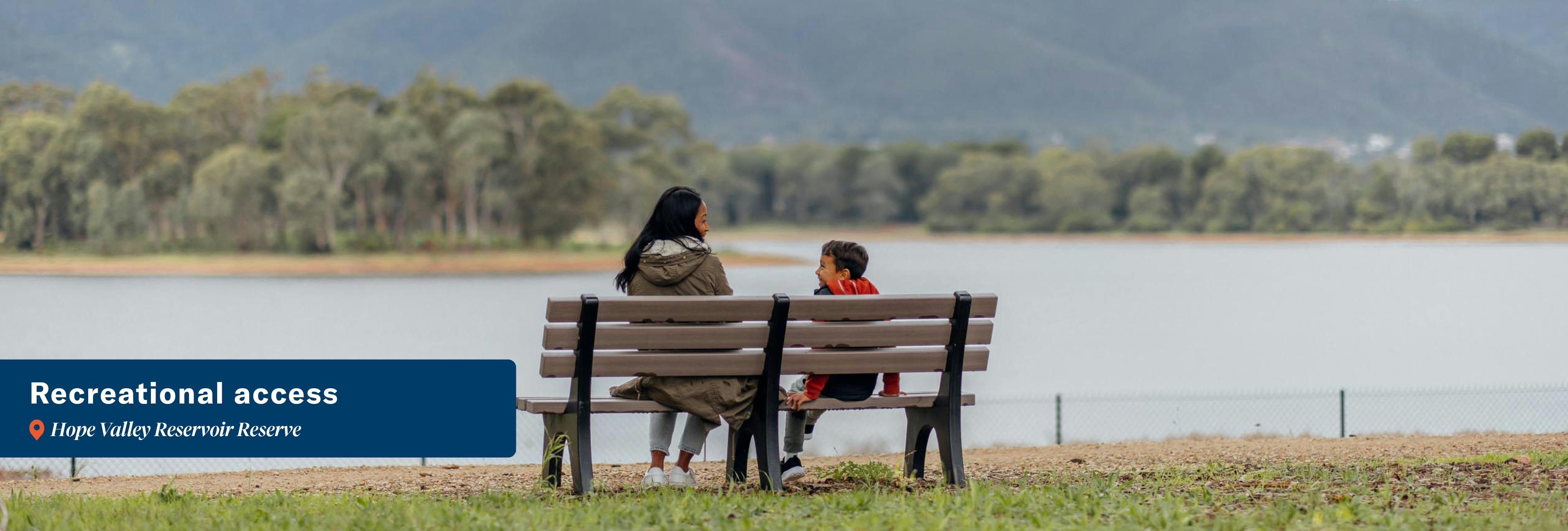Frequently Asked Questions
How many pine trees were affected by the Giant Pine Scale (GPS) outbreak?
Approximately 500 pine trees have been felled within Hope Valley Reservoir as a result of the GPS outbreak, primarily in the southeast of the reservoir reserve. Giant Pine Scale, an insect that sucks the sap of pine trees and causes dieback, does not pose a risk to the local community, or to water quality in the reservoir.
Why are there large amounts of mulch on site?
To effectively manage the risk of spread, all affected pine trees have been mulched, stockpiled on site and treated with a disinfectant. Based on advice from PIRSA, these mulch piles must stay in situ for a defined quarantine period (12 months). From March 2025, these mulch piles will then progressively be removed to make way for native revegetation.
What will be planted?
SA Water intends to create an open grassy woodland, using locally indigenous species, that retains views of the reservoir with clusters of shrubs. It is expected revegetation will occur in a staged manner over several years.
When will revegetation commence?
Following the removal of the mulch piles, it is anticipated that revegetation, using locally indigenous native species, will start from mid-2025. The area of revegetation will encompass the entire southeastern area of the reservoir reserve impacted by GPS.
What else is planned?
SA Water will also be enhancing the trail network by constructing approximately 1.2 kms of additional trail through the southeast of the reservoir reserve. This trail will link the dam wall and Awoonga Road, avoiding the need to walk on public roads in this area. We would welcome any views you have on this.
Why was this area chosen for expansion?
Through recent community surveys, the southeastern corner of the reservoir reserve was highlighted as a high priority for access, reducing the need to walk on the adjoining public roads and providing closer views of the reservoir. Opening of this area will half the amount of public road walking trail around the reservoir reserve.
When will works on the trail begin?
Following the removal of the mulch piles, it is anticipated that work on the walking trail will start from mid-2025.
When will the new trail be open to the public?
We aim to open the site to the public by the end of 2025.
Why does access need to be located outside of the catch drain?
Hope Valley Reservoir is a very small drinking water reservoir, serviced by a water treatment plant that is fit for purpose, but not designed to cater for any potential impacts of recreational access. To protect water quality, public access at Hope Valley occurs strictly in accordance with requirements as set out by SA Health. This includes restricting access outside of the catch drain and no access on or near the water.
Why can’t we have a walking trail around the whole reservoir?
The establishment of a new southeastern walking trail will avoid the need to walk along Lyons Road and Lower North East Road. Due to the presence of the water treatment plant and associated operational infrastructure, it is not feasible nor practicable to provide safe public access through the northern end of the reserve.
Will the section of new trail be locked after-hours?
Yes. As with the other sections of trail in the reservoir reserve, it will be locked after-hours as part of our obligation to protect drinking water safety.
Will the new trail be accessible for people with limited mobility?
While site constraints such as topography make it impractical to construct the trail to fully comply with the Disability Discrimination Act, the trail will be designed and constructed to provide access for most people with limited mobility.
Why can’t we bring our dogs to the reservoir?
Dogs can carry bacteria and viruses that could easily contaminate the water and present a risk to the safety of the drinking water. Dogs also pose a threat to local native animals.
How can I get involved?
SA Water is planning on running a community planting day in mid-2025 to support the revegetation works. There will also be ongoing opportunities to maintain and enhance this area through the Reservoir Volunteers program. More information on this to come.


